The Greeks at sea in WW2
Birth of the Greek Navy
Ancient Greece has been the cradle of naval power in the Mediterranean, inventing most of warships types of the antiquity like the diere and famous triere and the first naval tactics were codified. The Hellenistic states founded by the Diadochi, successors of Alexander the Great would also built the largest galleys ever put at sea. However the country was subjected to Rome, before getting its revenge through the Byzantine Empire up to 1453. After the fall of Constantinople, Greece passed under Ottoman rule. An embryo of Greek Navy emerged from the Independence war of 1821-29, official in 1828.
This was a hotchpotch of converted ships, Xebec-like bricks and wooden gunboats, but nothing up to the scale of a Turkish 3-decker. Against ships of the line, Greek sailors used fire ships, with heroes like Andreas Miaoulis. However only the help from western powers and in particular Russia (and its traditional links to the Byzantines through Orthodox Christianity) turned the tables entirely at the Battle of Navarino in 1827, the last with massive numbers of sailing ships of the line and one of the most decisive.
- Hydra class ironclads (1886)
- Kilkis class Battleships
- Nauarchos Miaoulis (1889)
- RHN Giorgios Averof (1910)
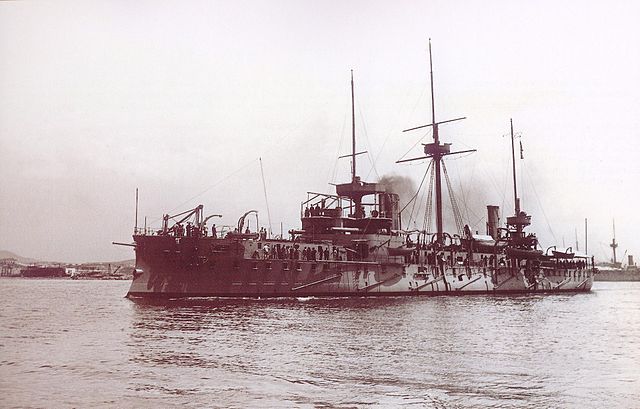
Hellenic Battleship Psara (1888)
Growth until WW1
But the navy really began its buildup from 1850 onwards. Its flagship was for long a Frigate, the Hellas. A second phase of growth began under King George I of Greece, especially after the 1878 nearby Russo-Turkish war. A large naval base was established at Faneromeni of Salamis and a Naval Academy founded, soon under strong influence from the french doctrine. In 1889 indeed, Greece’s first battleships Hydra, Spetsai, and Psara were ordered from France. This new fleet was seriously tested in the Greco-Turkish War of 1897. It helped establishing its dominance in the Aegean Sea, despite the situation on land. In 1907, the Hellenic Navy General Staff (Γενικό Επιτελείο Ναυτικού) was founded. In response to the Ottoman Fleet own acquisitions and purchased, a new naval race began, Greece ordering from Italy the cruiser Georgios Averof, for long its most potent asset. By 1910, the English style of management, organization and training was adopted, under supervision of Admiral Tuffnel.
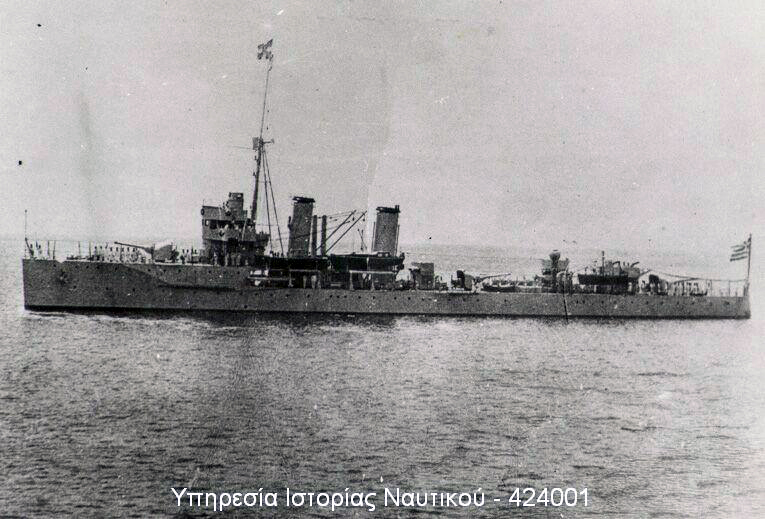
Elli (Hellas), a Cruiser built in the USA, initially for China. By 1941 she has been reclassified as a destroyer
The Greek Navy in the Balkan War
In 1912, conflict erupted again and Rear Admiral Pavlos Kountouriotis conducted operations to secure at Mudros and Lemnos the Dardanelles straits. The the Aegean Sea followed soon. In 1913, the situation escalated so much that the Greek government ordered more ships, taking delivery of two pre-dreadnoughts, battleships Lemnos and Kilkis from the US Navy and the light cruiser Elli also built in the USA for China first, a 2,600 ton Greek protected cruiser later reclassified as a destroyer. But most importantly the government ordered its first two dreadnoughts, the Bretagne class Vasilefs Konstantinos and the German-built Salamis, conventional design from AG Vulcan, Hamburg. None of them were delivered because of the Great War.
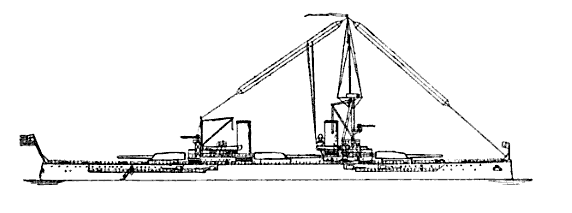
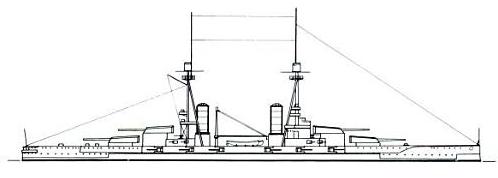
First and second designs of the 20,000 tons Salamis, built in Germany, by Vulkan AG. The ship would eventually be launched in November 1914 but only partially completed when all construction stopped in December. She would never receive her US-built guns, and after a long postwar procedure because the Greek government refuse the incomplete ship, she was awarded to the Shipyard, which eventually have her broken up in 1932.
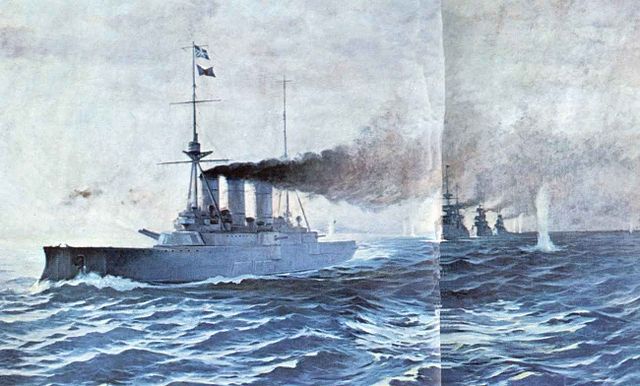
Battle of Elli, 16 December 1912, decisive Greek victory
The Greek Navy at the eve of WW1
In August 1914, Greece remains neutral, exhausted from the Balkan war and weary of a possible takeover of the central powers. At that time, the Hellenic Navy was strong enough to take on the Ottoman navy, by a margin, despite the not receiving its numerous orders.
The head of the British Naval Mission that became the Director of the Greek Naval Staff, Sir Mark Kerr, defined a new plan consisting of 3 light cruisers, 34 destroyers, 20 submersibles, 2 airships, 12 seaplanes and naval vessels. Turkish ambitions has been then clearly shown by the attempted purchase of the Rio de Janeiro for the Brazilians then under construction, and a new emergency plan on the eve of the war in this summer of 1914 included two 23,000-ton dreadnoughts, 1 cruiser, 4 destroyers and a submarine.
By the time the two Kilkis class battleships bought in the USA arrived in June 1914, they gave Greece a complete naval superiority in the eastern Mediterranean. Here are the detail of this fleet:
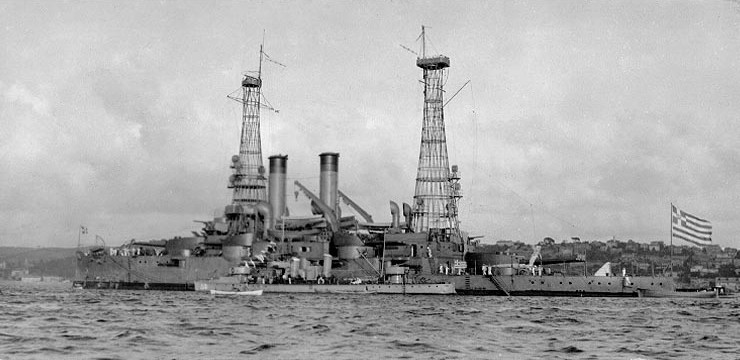
RHS Lemnos in 1919, a 1914 acquisition for the US. Both ships would still be in service by 1941.
-5 Battleships: 2 class Kilkis (1905, purchased in the USA in June 1914), three armoured cruisers class Hydra (1889). Projects: Salamis (Germany, 1913, launched November 1914, construction stopped in December 1914), purchase aborted of a Provence class sistership.
-3 Cruisers: Armoured cruiser Giorgios Averof (1910), cruiser Helle (1913), and the old Nauarchos Miaoulis (1879).
-14 Destroyers: 4 class Niki (1906), 4 class Thyella (1906), 4 class Aetos (1911), 2 class Keravnos.
11 TBs: 6 Class Aigli, 5 class NF11 (1885).
20 Miscellaneous: 2 submersibles class Delfin (1911), Minelayers Tenedos (1906), 3 class Aigialeia (1881). 4 Gunboats class Achelaos (1884), 2 class Ambrakia (1881), 2 class Kissa (1884), 3 class Alfa (1880), 2 class Plixavra (1858), training ship Basilissa Olga.
Also planned later: dreadnought battleships Basileus Konstantinos, Katsonis class cruisers.
Naval operations
With the beginning of the war it became clear that the orders started in Germany and France would never see the light of day. Sir Mark Kerr, tried to get the British to finance a Valiant-type battleship and a Southampton cruiser, with a deferred payment at the end of the war, but without much success. Greece stayed neutral at the beginning of the Great War, but constantly solicited by Churchill to assist the Royal Navy and the French Navy at the Dardanelles, even while Bulgaria was on his side. But internal political turmoil between a pro-German faction in the court of Constantine I and sympathizers of the Allied caused eventually the French to seize the entirety of the Greek fleet on 19 October 1916 to guarantee this neutrality. Some units passed under the French flag and control but with limited crew for maintenance.
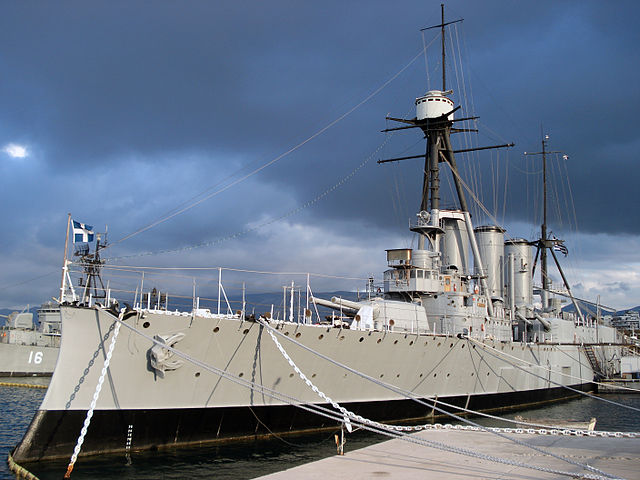
Armoured cruiser Giorgios Averoff, named after the Tycoon that financed her for the Greek Government.
After French troops landed at Salonica, a new provisional government hostile to the Monarchy was established, and Alexander I eventually abdicated in favor of his more liberal son Georges II. On July 2, 1917, Greece entered the war against the triple alliance, lending its ports to allied ships. With the surrender of Turkey in 1918, the Greek government saw the means of appropriating lands of the Ottoman Empire. On May 15, 1919, the fleet deployed and Greek troops landed in Asia Minor, seizing Western Anatolia and Izmir. The Treaty of Sèvres in 1920 confirmed the possession acquired in the Aegean Sea, but the Turkish counter-offensive finally forced the Greeks to leave Turkey at the end of 1922.
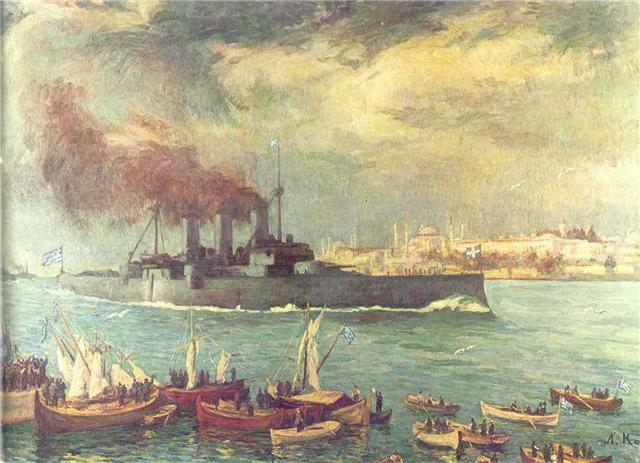
Averoff in the Bosporus, 1919
The Hellenic Navy in the interwar
Modernization was needed, but Greece went through a politically turbulent period, and was hit by the world financial crisis with an economy already in a bad state. The Navy had to make due with the adoption of only new submarines and new destroyers, with three main suppliers: France, Italy and UK. The motto eventually adopted would be Μέγα το της θαλάσσης κράτος – Méga to ti̱s thalássi̱s krátos “The rule of the sea is indeed a great matter” which relates to the famous words of Themistocles. Her flagship remains the Giorgios Averoff, last representation of an obsolete type, and the two pre-dreadnoughts of the Kilkis class reclassified as coastal battleships. Only in 1938 a radical step was taken, in an atmosphere of war weariness, with the adoption in UK of four destroyers of the Greyhound class (2 delivered). But there was nothing as ambitious as the 1913 naval plan. No major unit, cruiser or dreadnought was ordered because of a limited budget. Therefore neutrality was the only possible course.
The Hellenic Navy at the eve of WW2
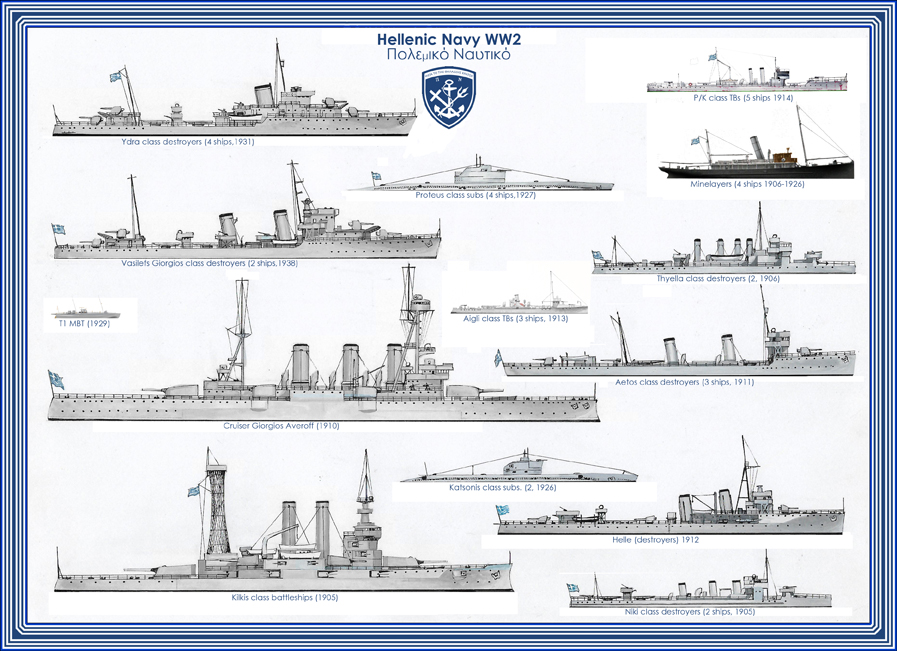
Poster showing all the types in service with the Hellenic Navy in 1941.
The traditional enemy of Greece, Turkey ordered 4 submarines and 4 destroyers, which added to the existing formidable Yavuz, former German battlecruiser Goeben, last existing example of such type of ship. She completely outclassed the Averoff, but still the guns and armour of the Kilkis class were a match in case she approached the coast enough.
Order of battle in 1941
On paper, the fleet consisted of 2 battleships, 1 armoured cruiser, 14 destroyers, and six submarines. In reality four of the oldest “destroyers” could have been re-classed as torpedo boats. The Helli (former protected cruiser, US-built, 1910) had been sunk indeed before the war on 15.8.1940.
-Armoured Cruiser Giorgios Averoff (1910) (default flagship)
-2 Battleships class Kilkis (Kilkis and Lemnos, 1905 American-built pre-dreadnoughts)
-14 Destroyers:
- Class Ydra (4 Italian-built ships, 1931)
- Class Vasilefs Giorgios (2 British ships, 1939)
- Class Nike (2, 1905)
- Class Thyella (2, 1906)
- Class Aetos (3, 1911) modernized 1920s
-6 Submarines: 4 Class Proteus, 2 class Katsonis, all French-built (1926-27).
-7 Torpedo-Boats: 5 class P/K (former Tb 82F Austro-Hungarian types), Aigi class (2, 1913).
-2 MTBs (Thornycroft CMB 1929 type, T1 class). T3-6 from Vosper were requisitioned by the Royal Navy in 1940 and 1941.
-4 Minelayers (auxiliary ships 1906-1926): Tenedos, Korgialenos, Paralos, Pleias. (see detail below)
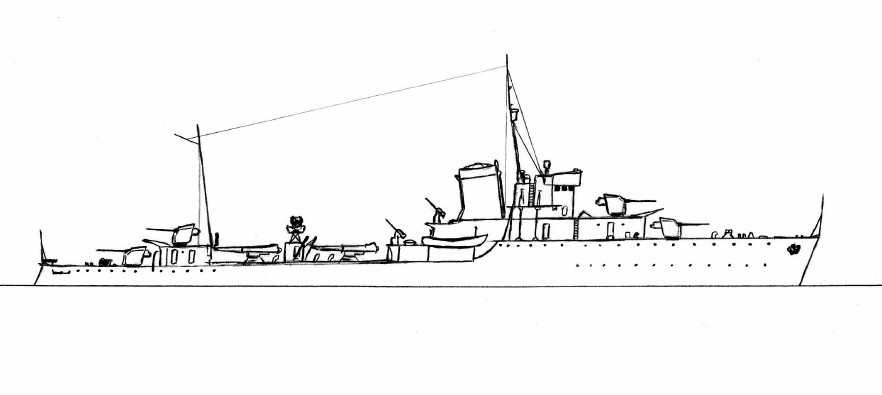
Drawing of the Ydra (wikipedia)
Naval Operations in 1941
Neural, Greece was however soon at war with Italy, seeing an easy conquest in the winter of 1940. The offensive commenced on 28 October 1940 and looked promising on paper, but proved an humiliation for Mussolini: 140,000 troops launched in Albania being poorly led and equipped soon ran into troubles by the weather, mountainous terrain and expert Greek counter-attack and guerilla warfare. This became quickly the stuff of legend and pride for the Greeks. The Greeks completely reversed the table with the capture of Klisura Pass in January 1941, launching a reconquest offensive, which was only stopped by Italian reinforcements of 28 divisions, and Spring Offensive in 1941, which only led to a February stalemate. Not willing to see her ally in such position, and seeing strategic assets for the control of the Mediterranean, Hitler unleashed his Panzerdivisions in the Balkans in April, 6.
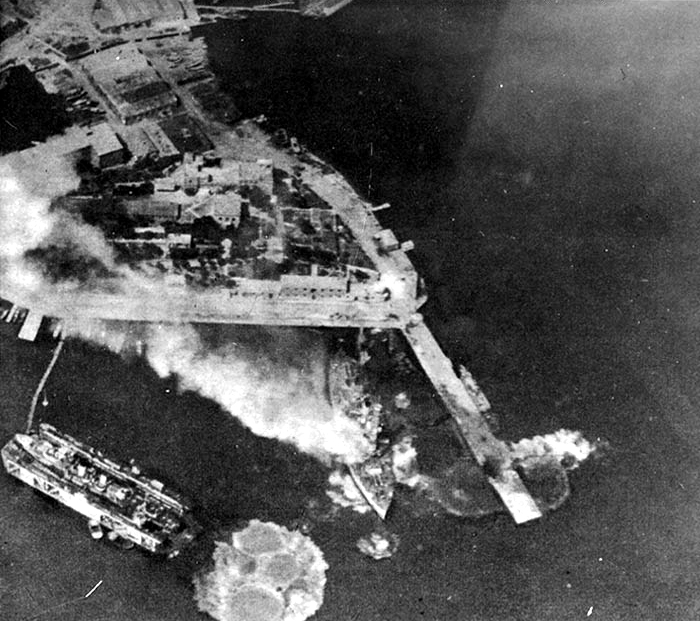
Greek battleship Kilkis under attack by German JU 87 dive bombers, at the Greek naval base at Salamis, 23 April 1941. In the lower left, in the floating drydock, is the destroyer Vasilefs Georgios. The floating dock and destroyer were also sunk, but Vasilefs Georgios was subsequently raised and placed in service by the German Navy as Hermes (ZG-3). Photograph and some caption information were provided by Franz Selinger. U.S. Naval Historical Center Photograph.
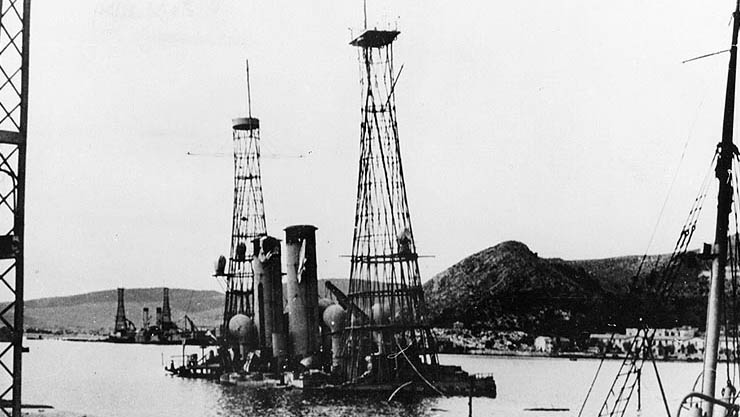
Aftermath of the attack at Piraeus, Kilkis and Lemnos in the background.
On the naval side, this started badly for Greece, even before the war: On 15 August 1940, Greek destroyer Elli has been sunk by the Italian submarine Delfino in Tinos harbour. Mussolini and Domenico Cavagnari (Navy’s Head) allowed indeed submarine attacks on neutral shipping prior to the attack. Another Greek ship was bombarded by Italian planes in Crete.
The Navy took over convoy escort missions in the Ionian Sea but conducted also conducted three raids against Italian supply convoys in the Strait of Otranto. Submarines became quickly the stars of the show, sink several Italian cargo ships in the Adriatic, without much response for the Italians, ill-prepared for ASW warfare.
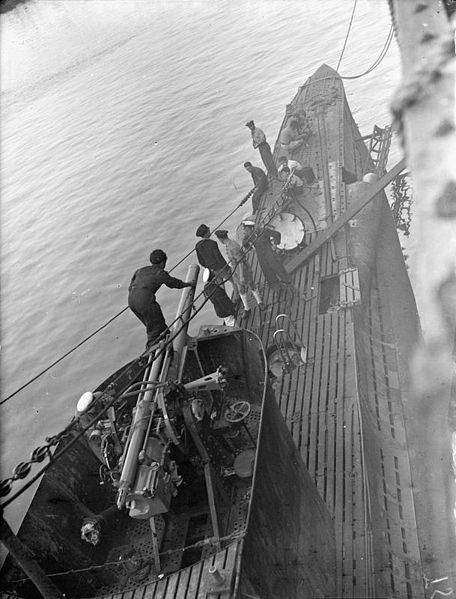
Greek Submarine Papamicolis, 30 Oct- Nov 1942 Beiruth, Syria.
The Royal Hellenic Navy (RHN) was totally outclassed by the more modern and larger Regia Marina. So the RHN avoided any direct naval confrontation. Patrol and convoy escort duties was the only possible course, displacing large quantities of matériel, and about 80,000 mobilized men, 100,000 mules moved by sea during in total. There were limited operations against Italian shipping, concentrated in the Strait of Otranto with submarines. Total: 23,000 long tons (23,000 t) of Italian shipping sunk (7 cargo ships, one escort vessel) for the loss of one submarine. However at no point the RHN was able to seriously hinder supply lines between Italy and Albania. Until 30 April 1941 Italian ships 3,305 voyages across the Otranto straits (487,089 personal or 22 field divisions, 584,392 tons of supplies). Destroyers also carried daring night raids on 14 November 1940, 15 December and 4 January 1941, but without much results.
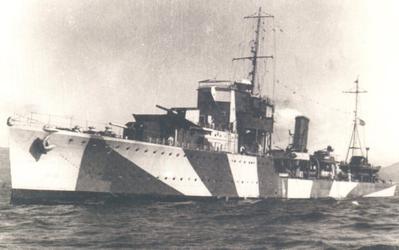
Destroyer RHN Vasilissa Olga
When the British entered the fray against the Strait of Otranto on 12 November, they played as a decoy force, driving attention westwards. Ultimately the Regia Marina would see half its capital ships out of action at Taranto (11–12 November). Nevertheless, Italian cruisers and destroyers went on in their escort missions with Albania. Corfu was bombarded by the Regia Aeronautica, and on 18 December and 4 March, Greek coastal positions were shelled and destroyed in Albania. From January 1941, the RHN was concentrating in escorting convoys for Operation Excess British reinforcements from Alexandria, in co-operation with the Royal Navy. The only Italian sortie against it degenerated in the Battle of Cape Matapan on 28 March and ending with the greatest Italian naval defeat at sea of the war.
Losses in operations included:
-Battleships of the Kilkis class: Both sunk in Piraeus harbor by the Luftwaffe 23.4.1941
-Destroyer Thyella: Sunk by Luftwaffe, April 1941
-Destroyer Leon (Aetos class) sunk Suda bay 22.4.1941
-Destroyers Psara (13.4.1941) and Ydra (22.4.1941)
-Submarine Proteus 19.12.1940
-TBs class P/K: Kios, Kyzikos, Pergamos, Kydonia, Proussa.
-All four Minelayers. Three later salvaged and reused by the Germans
-Both T1 MTBs sunk in 1941
The bulk of the fleet was sunk by April German air attacks. Stukas proved just as deadly as they were for the RN in this theater of operations, especially over Crete. Piraeus attack was like a mini pearl harbour.

Giorgio Averoff in the Indian Ocean, with its camouflage livery, 1942.
At war with the allies 1942-45
Despite the Axis occupation of Greece (Germany, Bulgaria and Italy), and growing partisan operations from 1942, reaching in peak in 1944, the Hellenic Royal Navy went on on the sides of the allies. Destroyers Aetos and Panther served as minelayers while together with the Lerax served under RN colors and control until the end of the war. Surviving ships, Georgios Averof, three destroyers and five submarines after 1941 joined the Mediterranean Royal Navy at Alexandria and went on soldiering until 1945 with further losses, but also many acquisitions that bolstered its forces.
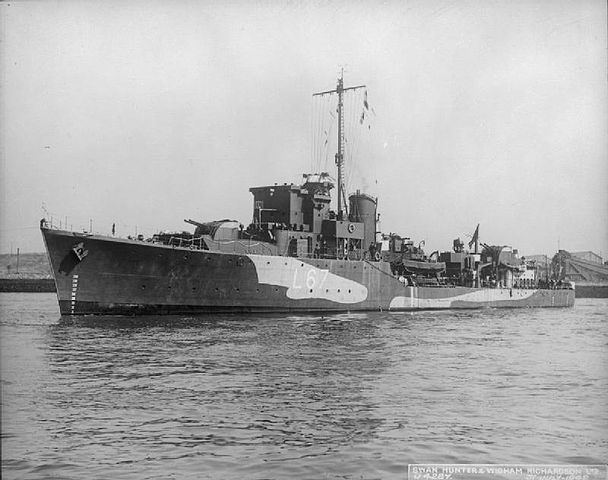
HHMS Adrias in service (IWM FL192)
New acquisitions :
As men were willing to fight and available, reaching the allies one way or another, the concession of several destroyers and submarines by the British Royal Navy to RHN could receive crews. The most notable Greek destroyer was the Vassilissa Olga, although sunk in Leros on September 23, 1943, was possibly one of the most successful Allied destroyer in the Mediterranean. Destroyer Adrias’s prow was blown off Kalymnos in October 1943 by a mine, but she managed to return to Alexandria in a 400-mile (640 km) trip after summary repairs a feat performed by the captain and crew. Two Greek destroyers also participated in Operation Overlord.
-Destroyers Navarinon and Salamis transferred in 1944
-Escort destroyers Adrias, Krite, Miaoulis, Pindos, Kanaris, Themistocles
-Corvettes Apostolis, Kriezis, Sakhtouris, Tompazis
-Submarines Amfitriti, Xifias, Pipinos, Delfin
-12 BTMS (ASW crafts, US-built, ex-British), MMS Tinos.
-Sub-chaser Vasilefs Giorgios II (ex. PC622), LST Khios, Lemnos, Lesvos, and Samos (ex. LST-35-33, 36, 37), still extant in the 1980s (one purchased back by the US Navy for preservation).
It should be added that Greek crewmen also served in a large array of small British auxiliaries, drifters, trawlers and whalers converted as ASW and patrol vessels.
New losses :
-Destroyers Vasilefs Giorgios (scuttled 7.5.1943), Vassilissa Olga (sunk 26.9.43)
-Submarine Katsonis, Gavkos, Triton.
-Ex-British escort destroyer Adrias
-BYMS Kos (ex. 2191 mined off Piraeus 15.10.1944)
Links, sources, Read more
en.wikipedia.org/wiki/Hellenic_Navy
naval-encyclopedia.com/ww1/pages/various/greece/grece1914.htm
Conway’s all the world fighting ships 1860-1905, 1906-1921, 1922-1947.
(Part II to follow: Detail of the ships, class by class and individual careers)

 Latest Facebook Entry -
Latest Facebook Entry -  X(Tweeter) Naval Encyclopedia's deck archive
X(Tweeter) Naval Encyclopedia's deck archive Instagram (@navalencyc)
Instagram (@navalencyc)





 French Navy
French Navy Royal Navy
Royal Navy Russian Navy
Russian Navy Armada Espanola
Armada Espanola Austrian Navy
Austrian Navy K.u.K. Kriegsmarine
K.u.K. Kriegsmarine Dansk Marine
Dansk Marine Nautiko Hellenon
Nautiko Hellenon Koninklije Marine 1870
Koninklije Marine 1870 Marinha do Brasil
Marinha do Brasil Osmanlı Donanması
Osmanlı Donanması Marina Do Peru
Marina Do Peru Marinha do Portugal
Marinha do Portugal Regia Marina 1870
Regia Marina 1870 Nihhon Kaigun 1870
Nihhon Kaigun 1870 Preußische Marine 1870
Preußische Marine 1870 Russkiy Flot 1870
Russkiy Flot 1870 Svenska marinen
Svenska marinen Søværnet
Søværnet Union Navy
Union Navy Confederate Navy
Confederate Navy Armada de Argentina
Armada de Argentina Imperial Chinese Navy
Imperial Chinese Navy Marinha do Portugal
Marinha do Portugal Mexico
Mexico Kaiserliche Marine
Kaiserliche Marine 1898 US Navy
1898 US Navy Sovietskiy Flot
Sovietskiy Flot Royal Canadian Navy
Royal Canadian Navy Royal Australian Navy
Royal Australian Navy RNZN Fleet
RNZN Fleet Chinese Navy 1937
Chinese Navy 1937 Kriegsmarine
Kriegsmarine Chilean Navy
Chilean Navy Danish Navy
Danish Navy Finnish Navy
Finnish Navy Hellenic Navy
Hellenic Navy Polish Navy
Polish Navy Romanian Navy
Romanian Navy Turkish Navy
Turkish Navy Royal Yugoslav Navy
Royal Yugoslav Navy Royal Thai Navy
Royal Thai Navy Minor Navies
Minor Navies Albania
Albania Austria
Austria Belgium
Belgium Columbia
Columbia Costa Rica
Costa Rica Cuba
Cuba Czechoslovakia
Czechoslovakia Dominican Republic
Dominican Republic Haiti
Haiti Hungary
Hungary Honduras
Honduras Estonia
Estonia Iceland
Iceland Eire
Eire Equador
Equador Iran
Iran Iraq
Iraq Latvia
Latvia Liberia
Liberia Lithuania
Lithuania Mandchukuo
Mandchukuo Morocco
Morocco Nicaragua
Nicaragua Persia
Persia San Salvador
San Salvador Sarawak
Sarawak Uruguay
Uruguay Venezuela
Venezuela Zanzibar
Zanzibar Warsaw Pact Navies
Warsaw Pact Navies Bulgaria
Bulgaria Hungary
Hungary

 Bundesmarine
Bundesmarine Dutch Navy
Dutch Navy Hellenic Navy
Hellenic Navy Marina Militare
Marina Militare Yugoslav Navy
Yugoslav Navy Chinese Navy
Chinese Navy Indian Navy
Indian Navy Indonesian Navy
Indonesian Navy JMSDF
JMSDF North Korean Navy
North Korean Navy Pakistani Navy
Pakistani Navy Philippines Navy
Philippines Navy ROKN
ROKN Rep. of Singapore Navy
Rep. of Singapore Navy Taiwanese Navy
Taiwanese Navy IDF Navy
IDF Navy Saudi Navy
Saudi Navy Royal New Zealand Navy
Royal New Zealand Navy Egyptian Navy
Egyptian Navy South African Navy
South African Navy






























 Ukrainian Navy
Ukrainian Navy dbodesign
dbodesign